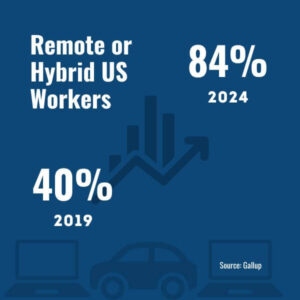Why do we need to consider the pros and cons of telecommuting? One reason (although not the best one) is because it’s everywhere, and it’s not going away.
In recent years, the shift toward remote work has gained significant momentum, with a noticeable increase in flexible work arrangements across various sectors. According to a survey from Gallup, roughly 84% of US full-time, remote-capable workers either work exclusively from home or have a hybrid work schedule. That’s up from 40% from 2019—a 110% increase!
Today, telecommuting is more often referred to as hybrid or remote work. But despite new names and excitement around it, the concept itself isn’t new. In fact, over 10 years ago, when a tech giant announced a major policy change that deauthorized remote work, I wrote a post about the pros and cons of telecommuting . But with that and other original examples now outdated—and with so much evolution in the conversation since that time—this seems a great moment to publish an update.

First, let’s look back at some concepts from that long-ago post:
The (Now Former) In-Office Paradigm
Note: this has changed—a lot—but it’s still the foundation we’re working from as we navigate remote and hybrid work today.
Our obsession with working in offices was an established mental model that needed to change.
Yes, of course, there are advantages to people getting together. But there are also great advantages to flexible working arrangements!
And although these 2 things don’t have to be mutually exclusive, pre-COVID, we often struggled to think outside the box of “traditional” offices. And since then, we’ve been fumbling through hybrid models, in part because that office paradigm was as strong as any other—and one that so many worked tirelessly to uphold for decades.
It drives me crazy when I hear things like this:
- “She’s the right candidate in every other way, but the job is in Atlanta and she’s not.”
- “Our new brand manager must be located in the home office.”
- “We might lose this employee to a competitor if he can’t work from home, but we have to follow our company policy.”
Does your company prioritize geography over quality? As a leader who knows that you’re only as good as the people on your team, how can you possibly convince me that this makes good business sense?
A Bit of History on the Office vs. the Home Office
For some reason, we tend to think of “traditional” offices as a given— the norm some companies choose to deviate from. But that’s inaccurate.
In truth, this type of office has only been around since the early 1900s. And it was designed in response to a challenge that no longer exists:
As businesses grew from local to national to global enterprises, it became clear that colleagues needed to be in the same physical space in order to communicate. Hence, the rise of the office.
Today, geography no longer limits teams’ ability to communicate in real time. In fact, some of the most disastrous communication problems I deal with happen among people who work in the same office and see one another many times a day.
The Pros of Telecommuting or Remote Work
Telecommuting has many advantages. It can support
- Greater productivity
- Higher discretionary income for employees (I know your Zoom wardrobe is on point, but still)
- Lower cost of space
- Lower relocation costs
- Reduced pollution
- Access to talent
The last one is the major game-changer.
Many high-capability people want flexibility. You can throw every benefit in the world their way, but if you take away the option of hybrid or remote work, you’ll lose them. Plain and simple.
Is that worth it?
At the end of the day, an office requirement can say a lot about an organization as a whole: are you people focused and flexible, or out-of-touch and demanding?
Is the message your policies send in sync with your culture?
The Cons of Telecommuting
Of course, hybrid and remote work also brings challenges:
It can be more difficult to brainstorm, to tap into the “feel” of group dynamics in a remote meeting or creative session.
And there’s no substitute for the shared experience of those “you had to be there” moments.
As a result, remote team members can miss out on the group’s support and find themselves feeling out of the loop. They can get lonely and feel isolated.
The leaders of remote teams need to be prepared for this and more.
Where We Are Today
Okay, back to the present:
The fact is, while my own opinions on the pros and cons of telecommuting, remote, or hybrid work haven’t changed, the landscape has shifted drastically—in a good way. These days, leaders are not as often focused on whether or not we should allow hybrid work, but rather on how we can evolve to incorporate at least some aspects of it into our corporate culture—if for no other reason than to keep on a level playing field with the other employers out there.
With such a dramatic change in the acceptance and implementation of remote work models, it’s worthwhile for leaders to dig into this conversation, and adopt a smart approach.
Here’s a direct excerpt from my 2013 post, and it’s still a great way to wrap up:
This all comes down to balance and empowerment instead of black-and-white policies.
Talk to your people about the above concerns, and ask them (not top management) to come up with ideas that address the challenges of remote working.
Instead of starting with your own top-down solution, start by listening.
Then let your team experiment with their solutions, diagnose the results, and adjust.
And if you manage work-from-home employees, focus on keeping them informed, in touch, and included.
If you’d like to discuss any specific challenges you’re having as you navigate the pros and cons or telecommuting, please get in touch.

And bravo to you for your effort, intention, and care!
– Bill




Leave a Reply